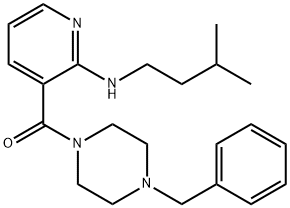NSI-189
- CAS NO.:1270138-40-3
- Empirical Formula: C22H30N4O
- Molecular Weight: 366.5
- MDL number: MFCD26959792
- EINECS: 1592732-453-0
- SAFETY DATA SHEET (SDS)
- Update Date: 2024-11-19 23:02:33

What is NSI-189?
Description
NSI-189 is an investigational drug being developed by Neuralstem Inc., a biopharmaceutical company. NSI-189 is a small molecule in clinical development for major depressive disorder (MDD) and in preclinical development for Angelman syndrome, irradiation-induced cognitive impairment, Type 1 and Type 2 diabetes, and stroke. NSI-189 was studied in phase I and II clinical trials for the treatment of major depressive disorder. As of July 2017, NSI-189 has failed to meet effectiveness outcomes for depression in phase II trials.
The Uses of NSI-189
NSI-189 is an experimental, potential antidepressant, for the treatment for major depressive disorder (MDD), as well as for cognitive impairment and neurodegeneration.
Side Effects
NSI 189 is not approved by the FDA, and there is not enough scientific information available to verify its safety. To lessen any potential side effects, it is advisable to only take the lowest possible dose of the compound at first in order to judge how it will affect the body. The possible side effects of this compound include nausea, fatigue, heart palpitations, headache, increased anxiety, visual perception changes, loss of memory, dissociation, decreased appetite, increased heart rate, delirium, and a drop in blood sugar.
As there have been no long term studies for this compound, the long term effects and overall safety are unknown. For this reason, it is not suggested to take the compound if an individual is pregnant or breastfeeding. It is also not advisable to take the compound if an individual is taking a prescription medication for the treatment of depression, neuropathy, or if they have low blood sugar.
Clinical claims and research
NSI-189 completed a phase I clinical trial for MDD in 2011, where it was administered to 41 healthy volunteers.A phase Ib clinical trial for treating MDD in 24 patients started in 2012 and completed in July 2014, with results published in December 2015. In July 2017, it was announced that a phase II clinical trial with 220 patients failed to meet its primary effectiveness endpoint in MDD.Upon the announcement, Neuralstem stock plummeted by 61%.More detailed analysis of the trial results was released in December 2017 and January 2018. The compound has gone through phase I and II clinical trials for its antidepressant properties, but the phase II trial failed to meet effectiveness outcomes. It is currently still being studied as a possible treatment for other conditions.
Mode of action
NSI-189 is a compound that may increase the birth of new neurons (neurogenesis) in the brain area known as the hippocampus. It works by stimulating the growth of new brain cells and nerve cells through a process called neurogenesis. The neurogenesis appears to affect the hippocampus primarily, which is responsible for learning, memory, and emotion. Scientists believe the compound has the potential to treat various neurological and nerve conditions.
Properties of NSI-189
| Boiling point: | 534.7±50.0 °C(Predicted) |
| Density | 1.134±0.06 g/cm3(Predicted) |
| storage temp. | -20°C |
| solubility | Soluble in DMSO |
| pka | 6.18±0.10(Predicted) |
| form | A crystalline solid |
| color | White to yellow |
| λmax | 254 nm |
| InChI | InChI=1S/C22H30N4O/c1-18(2)10-12-24-21-20(9-6-11-23-21)22(27)26-15-13-25(14-16-26)17-19-7-4-3-5-8-19/h3-9,11,18H,10,12-17H2,1-2H3,(H,23,24) |
Safety information for NSI-189
Computed Descriptors for NSI-189
| InChIKey | DYTOQURYRYYNOR-UHFFFAOYSA-N |
| SMILES | C(C1=CC=CN=C1NCCC(C)C)(N1CCN(CC2=CC=CC=C2)CC1)=O |
New Products
4-AMINO-TETRAHYDRO-PYRAN-4-CARBOXYLIC ACID HCL 4-(Dimethylamino)tetrahydro-2H-pyran-4-carbonitrile 4-Aminotetrahydropyran-4-carbonitrile Hydrochloride (R)-3-Aminobutanenitrile Hydrochloride 3-((Dimethylamino)methyl)-5-methylhexan-2-one oxalate 1,4-Dioxa-8-azaspiro[4.5]decane 5-Bromo-2-nitropyridine Nimesulide BP Aceclofenac IP/BP/EP Diclofenac Sodium IP/BP/EP/USP Mefenamic Acid IP/BP/EP/USP Ornidazole IP Diclofenac Potassium THOMAIND PAPER PH 2.0 TO 4.5 1 BOX BUFFER CAPSULE PH 9.2 - 10 CAP SODIUM CHLORIDE 0.1N CVS ALLOXAN MONOHYDRATE 98% PLATINUM 0.5% ON 3 MM ALUMINA PELLETS (TYPE 73) LITHIUM AAS SOLUTION 2-Bromo-1-(bromomethyl)-3-chloro-5-nitrobenzene 2-Bromo-3-nitroaniline N-(3-Hydroxypropyl)-N-methylacetamide 3-Bromo-6-chloropyridazine 4-ethyl-3-nitrobenzoic acidYou may like
-
 NIS-189 99% (HPLC) CAS 1270138-40-3View Details
NIS-189 99% (HPLC) CAS 1270138-40-3View Details
1270138-40-3 -
 1-Methyl-6-oxo-1,6-dihydropyridazine-3-carbonitrile 98%View Details
1-Methyl-6-oxo-1,6-dihydropyridazine-3-carbonitrile 98%View Details
99903-60-3 -
 1823368-42-8 98%View Details
1823368-42-8 98%View Details
1823368-42-8 -
 2-(3-(tert-butyl)phenoxy)-2-methylpropanoic acid 1307449-08-6 98%View Details
2-(3-(tert-butyl)phenoxy)-2-methylpropanoic acid 1307449-08-6 98%View Details
1307449-08-6 -
 Ethyl 3-(furan-2-yl)-3-hydroxypropanoate 25408-95-1 98%View Details
Ethyl 3-(furan-2-yl)-3-hydroxypropanoate 25408-95-1 98%View Details
25408-95-1 -
 2-Chloro-5-fluoro-1-methoxy-3-methylbenzene 98%View Details
2-Chloro-5-fluoro-1-methoxy-3-methylbenzene 98%View Details
1805639-70-6 -
 1784294-80-9 98%View Details
1784294-80-9 98%View Details
1784294-80-9 -
 Lithium ClavulanateView Details
Lithium ClavulanateView Details
61177-44-4